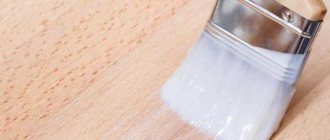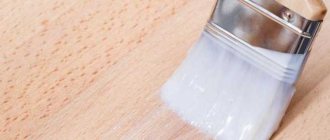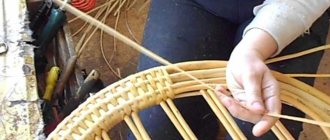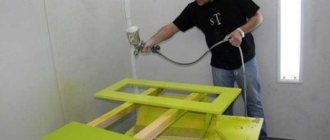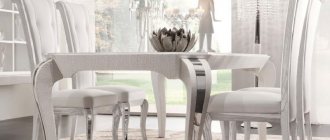Simple ways to give furniture an antique look
In order for carpentry to quickly acquire a pompous look with a flair of antiquity, you need to use effective decorative methods:
- Brushing allows you to expressively highlight the unique images of growth rings and corrugations on solid wood. During the process of natural aging, the surface of the wood cut becomes dull and the natural pattern becomes much brighter than the surrounding background. It is not difficult to artificially create such a visual effect by treating the surface of furniture products with steel brushes or sandblasting equipment in the factory. At the final stage of decoration, it is necessary to cover the surface with wax or varnish.
Brushing will highlight the unique texture of the wood
- Gilding gives wooden interior items a noble look with an emphasis on precious finishes to match the antiquity. A common method of decorating furniture facades is gilding with gold leaf (specialized foil with a color characteristic of a valuable metal). The shiny material is finely crushed, glued to the base, processed with a soft brush to remove the edges of gold fragments and polished for fixation.
Gilding gives furniture a noble look
- Patination creates the appearance of plaque formation, symbolizing the long service life of the joinery. Often, the effect of patina on furniture is expressed in the finishing of corners, recesses, and recesses in a color different from the base. A similar look can be achieved simply by using textured paint, shellac or bitumen varnish.
Patination will make furniture more impressive
The unique design of antique furniture, captivating with decorative delights, has an amazing similarity to genuine antiques. Therefore, it is wise to master the basics of decorating old carpentry, which can look brilliant after skillfully carried out restoration.
Features of decorating an antique kitchen
Even a very fashionable and modern kitchen can be artificially aged if you use some techniques and decorative items:
- The wooden facades of the cabinet can be slightly sanded, partially removing the layer of varnish or paint from them, or you can use one of the previously listed aging methods;
- remove the cabinet doors and place wicker baskets on the shelves;
- One of the classic elements of an ancient kitchen is a stove or hearth. In a modern room, you can create an imitation of them in the cooking area or lay out a large false fireplace next to a wall where there is no furniture, made of artificial stone. Another imitation option is photo wallpaper in the form of a full-size fireplace;
- To create an antique interior, you can hang ancient kitchen utensils along the walls, place jars on shelves, and place trays and pots next to them;
- choose the right textiles for the interior - bright potholders and embroidered tablecloths, lay woven ancient rugs on the floor;
- hang lamps decorated in antique style;
- decoration using braids based on garlic and onions, bunches of dried herbs, as well as vegetables in wicker baskets.
To create an original antique interior, wood should be used as a defining element ; it can be artificially aged using special techniques that were described above. In addition, the interior of the kitchen or other room should be supplemented with antique decorative elements and objects that emphasize the chosen style.
Preparatory work before starting the aging process
The appearance of furniture that still has a margin of safety, but cannot be used for its intended purpose due to the loss of its former luster, can be improved. If you have to work with chairs whose surface is coated with polish, you need to get rid of it by using a special compound purchased for this purpose at a hardware store. The surface can be covered with paint, which also needs to be removed using sandpaper; it needs to be worked until the base becomes smooth. The furniture may not be painted, then it is necessary to remove dirt from the surface using fine-grained sandpaper.
Before aging a chair, it is necessary to thoroughly clean its surface with sandpaper or a sanding machine.
It is important that the base is free of grease deposits. During the work process, it is recommended to use a respirator that will protect the respiratory tract, and the room in which the master works should be well ventilated. You should not begin further work after removing the top layer from the furniture until the room has been vacuumed and the surface of the product has been wiped with a damp cloth.
Due to the fact that you will be working with objects that have served for decades, their surface must be degreased by treating with a soap solution, after which the chairs must be left to dry. Puttying is not required, since a perfectly smooth surface is not needed, because the purpose of the work is aging, which involves slight wear; for this reason, defects in the base of the wood should be emphasized and not masked with the mixture.
Antique interior styles and materials
In addition to wood of various species, materials such as:
- ceramics;
- stone;
- copper;
- bronze.
The following types of wood are used:
- pine;
- spruce;
- maple;
- birch;
- aspen and others.
The arrangement of an antique interior depends on the type of room and the chosen style. For antique interiors styles such as:
- romantic;
- chalet;
- Russian village;
- Provence;
- American Country;
- Empire style
Applying protection to a painted surface
In order to protect the chair from rotting, it is necessary to cover its surface with a layer of wax.
All applied layers must be protected, for which you can use wax, which is represented by mastic made on the basis of wood wax. If water-based paint was used in the work, then this composition will perfectly protect it from exposure to water.
Wax can be purchased in clear or dark versions. The composition should be applied using rags that are not capable of leaving fibers; a traditional foam sponge will also work. The composition should be applied evenly to the base that has been painted, then rubbing must be carried out. In order for the composition to be completely absorbed and dry, it will take 15 minutes.
A protective layer can help adjust the resulting paint color. This can be done in two steps. To do this, the first layer should be transparent wax, which should be applied over the wooden base. After this, dark wax should be applied, which will give the furniture a certain effect, but for this the composition should be applied only in the right places.
If you want to make the previously applied paint with your own hands darker, then the dark wax should be distributed over the entire surface, replacing the transparent composition. It is also recommended to start experiments from the back of the chair. This will help you understand whether the resulting effect is suitable.
If the chairs you have decorated in an antique style are used quite often, they can additionally be protected with a matte acrylic compound designed for wood. Such coverage must be renewed periodically – once every 6 months. To care for such pieces of furniture, you need to use damp rags and special wood care products.
Chairs can also be decorated with unusual vintage elements, which today are easy to purchase in relevant goods stores or at stock exchanges. Such a minor addition will be a worthy completion of the master’s creative project.
Armchairs, if they have wooden components, for example, armrests or decorative legs, can be decorated using one of the described technologies. The main thing is that this piece of furniture is in harmony with the rest of the interior of the house or apartment.
Lumber from a warehouse in Moscow
Wood aging methods
To create a “antique” interior made of wood in a room, several methods of artificially aging the material are used:
- chemical - can only be used for hardwood products;
- thermal or firing method - can be used for any type of wood;
- Brushing or mechanical methods are used to age oak and coniferous wood.
Features of brushing
For artificial aging, it is better to choose materials from coniferous wood:
- spruce;
- larch;
- pine.
They have a pronounced structure and pattern, which is formed by fibers of different hardness, which greatly facilitates the brushing procedure.
With the help of devices that destroy the top layer of wood, the “antique” effect can be achieved quite quickly. So, cracks and abrasions can be imitated in the following ways:
- On the surface of a log, board or beam, using the sharp angle of an ax, apply potholes of different depths and widths in a chaotic manner. The corners on the block are slightly cut off with an axe, but this should not look perfect. Next, all surfaces treated in a similar way are sanded with a stiff brush with steel bristles. But for grinding a large product, it is better to use a grinder or a drill with the required attachment. Grinding is continued until all the sharp edges that appeared when chopping with an ax no longer show the appearance of damage resulting from the aging of the product. The brush should only go along the grain. Then you need to sand using a special sandpaper, which removes protruding fibers, and then with a steel brush with soft bristles. Some soft fibers are removed by creating small depressions between the ridges based on the winter fibers of the tree. With the same brush you can additionally highlight cracks and knots;
- After finishing the processing of light surfaces on a new product, they need to be externally closer to those that have darkened over time. To do this, they are treated with acrylic paint or stain. Once dry, lightly rub the wood with medium-grain sandpaper, without pressing it, while removing paint from raised areas and ridges. Dark color should also be present in the spaces between the grains and in the gouges. The final finishing of the surface is coating with acrylic varnish of a transparent or light yellow shade and completely drying;
- brushing by hand using a brush with metal bristles. Can be practiced for small products, furniture and utensils made of wood. The soft fibers should be removed and the hardwood ridges left. Wood dust is removed with a hair brush; the degree of readiness is determined at your discretion in terms of achieving one or another degree of wear. Next, the product is painted and decorated according to the method described earlier.
Chemical and thermal method of wood processing
These methods can be called quite close, since such destruction of the top layer of material occurs practically without mechanical influences . However, both methods are quite dangerous; wood must be processed outside, observing all safety measures.
Heat treatment (firing) involves the destruction of soft fibers through exposure to open fire. During processing, the surface of the product is burned using a gas torch or blowtorch. The firing depth should be about 3 mm; if it is smaller, the “antique” effect will be more difficult to achieve. The process needs to be adjusted depending on your taste.
When the top layer of wood is charred, take a metal brush or drill attachment and scrape off the carbon deposits until the desired texture and shade are obtained. When aging wood, you don’t have to paint it, since it will already have dark and light areas. Finishing refers to sanding and varnishing.
But the chemical method of treating wood “antique” is carried out through alkaline action or ammonia. For this purpose, aerosols are used to clean slabs and drains. Before using any product, you need to make sure that it contains alkali. Also take precautions when using it.
When contacted with the surface of a tree, such products partially burn the soft fibers, and the wood acquires a gray tint. After treatment, the surfaces should be rinsed with water and treated with a weak solution of citric acid and vinegar, removing what remains of the alkali. The vinegar should be 9 percent table vinegar, not an acid. After drying the product, if necessary, brush it and paint it.
Features of brushing
This is one of the most modern and fashionable ways to show how to age natural wood furniture. Medium-density wood is suitable for processing using this method - walnut, coniferous species, oak - it is this that provides a pronounced and very beautiful pattern of the treated surface. The name “brushing” comes from the English word brush: using special metal brushes, the surface is mechanically processed. Most often, the method is used to create interior items in country or Provence style.
The structure of the wood is heterogeneous; dense fibers alternate with looser ones, forming a unique pattern. Under the influence of time, the soft areas are destroyed, giving the tree relief. Today this process can be significantly accelerated, obtaining the desired aging effect in a very short period.
The surface is simply processed in several stages. First, hard metal brushes are used, which rid the wood of soft and loose fibers. The dense texture becomes distinct, and growth rings appear. Then they pass over it with special nylon brushes with abrasive inclusions, which remove roughness. For work, you can use a grinding machine, a drill with special attachments, or a milling cutter.
Wood that ages under natural conditions becomes brittle, loses elasticity, and cracks. Artificial aging of the product allows you to preserve the strength and all the properties of new wood using modern compounds.
The last stage is polishing using sesal brushes or thick felt. After this, the surface is primed and treated with the desired tint compositions, which further emphasize the beauty of the design. It is possible to cover the protruding parts of the surface with a dark stain that contrasts with the light color of the soft fibers. This technique will visually enhance the aging effect. The final varnish coating protects the surface from external influences and adds shine and gloss to it. Brushed boards are great for making antique furniture with your own hands. If necessary, products aged using this method can be returned to their original appearance by simply cleaning the surface.
Master classes on making transformable furniture with your own hands at home
Hard metal brush
Nylon brush with abrasive inclusions
Sesal brush
Design of antique furniture and appliances
If you decide to create an antique interior in the kitchen, then you need to choose its elements according to the design. So, furniture can be not only made of wood, but also:
- forged;
- wicker;
- stone;
- brick.
You can use stone to create cabinet cabinets in the kitchen , where there are shelves for storing accessories, or where built-in appliances are located.
However, regardless of the material of the headset, it should have a fairly simple appearance. If desired, the facades should be replaced with chintz curtains. Excellent antique interior elements in the kitchen will be:
- chests;
- rough stools;
- benches.
If household appliances cannot be hidden behind curtains and facades, then it is recommended to choose them in a style that is harmonious for the interior - based on enamel or metal, the same applies to plumbing fixtures. Faucets made of bronze or copper, counter-mounted stone sinks and much more are perfect.
Required Tools
On thematic resources you can choose a suitable master class on making beautiful furniture at home, which is difficult to distinguish from antique products. Depending on the algorithm of actions prescribed in it, the set of tools will differ. To create furniture at home, you may need manual, electrical and measuring instruments, as well as additional equipment and consumables. You should prepare in advance:
- pencil (marker), ruler - for marking;
- squares, tape measure, level - to control the accuracy of measurements;
- drill, jigsaw, screwdriver - for cutting parts and drilling holes;
- saws for wood and metal, screwdrivers, drills, crowns, chisels, knives, clamps, hammer, planes of various sizes;
- A manual milling machine would also be useful.
How to arrange furniture in a one-room apartment, advice from designers
The same tools will be needed if you plan to age furniture that is already in the interior. In addition, you definitely need to take care of the presence of a wood primer, stain or glaze, and varnish. If patination is used, paint that serves as a base (usually acrylic) and wood processing products are purchased. Brushes of various widths, rags, and cloth will also be useful for final polishing of finished elements.
Ruler and pencil for marking
Screwdriver
Jigsaw
Brushes and nozzle
Saw for wood and metal
Manual milling machine
Preparation for wood processing
Wood processing is carried out using the following tools and materials:
- paint brushes;
- axe;
- brush with metal bristles;
- grinder or drill with attachments;
- hair brush;
- sandpaper;
- acrylic paint;
- wax;
- clear varnish;
- stain.
When purchasing timber or boards with which you plan to create a “antique” interior, you can choose even those that have visible flaws:
- bug damage;
- presence of potholes and chips on the surface;
- knots and cracks.
All of the listed shortcomings in an antique interior will look quite harmonious.
Furniture for antique finishing should be chosen that is a little rough, massive or in a rustic style, which should resemble homemade furniture made of wood from the 20th century. Before processing, it is better to disassemble the furniture, if this is provided for by the design. This will allow you to decorate all components, including hard-to-reach areas.
Before you start decorating for the first time, you need to practice on separate boards or blocks of wood. On them, select paints or stains according to tone in order to evaluate the future result of the work. Manipulations such as drying, painting or brushing should be performed outdoors.
